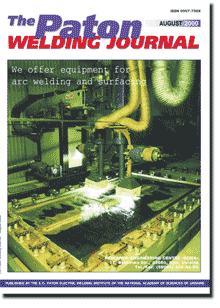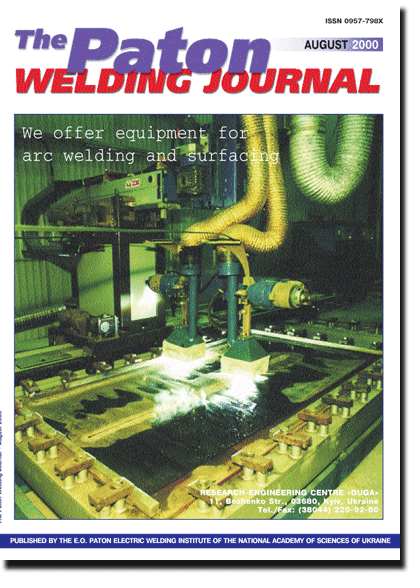

| SCIENTIFIC AND TECHNICAL | |
|
BYKOVSKY O.G., PINKOVSKY I.V. and PATYUPKIN A.V. IMPROVEMENT OF CAVITATION-EROSION RESISTANCE OF CLAD PARTS OF HYDRAULIC MACHINERY | 3 |
| High-temperature impact on the metal surface in cavitation erosion has been confirmed. Application of dispersion-hardening alloys with an unstable structure is recommended for its elimination. Control of thermal cycle and cladding technique enables a considerable improvement of the cavitation-erosion resistance of the deposited metal. | |
|
GAVROV E.V. COMPOSITE POLYMETALLIC ELECTRODE WIRES | 8 |
| Results of investigations conducted by the Zaporizhya State Technical University for over 30 years in the field of development and practical application of polymetallic wires for welding, surfacing and metallization of copper alloys of different alloying systems are presented. General principles of development of copper-base polymetallic wires which can be successfully used, upon proper correction, for design and manufacture of wires for welding, surfacing and metallization of other alloys are described. | |
|
GUK V.A. MATERIALS AND TECHNOLOGY FOR SURFACING OF MACHINE PARTS OPERATING UNDER CONDITIONS OF IMPACT-ABRASIVE WEAR | 11 |
| Compositions and structures of deposited metal produced using consumables of different alloying systems were analysed. Performance of the deposited metal under conditions of impact-abrasive wear was evaluated. Composition of a new flux-cored wire ensuring high wear resistance of rotary crusher beaters is suggested. | |
|
POPOV S.N. WEAR RESISTANCE OF METAL DEPOSITED ON WORKING PARTS OF ROAD-BUILDING MACHINES DURING THEIR OPERATION | 14 |
| Three groups of surfacing alloys characterized by a different content of the hardening phase are considered. The effect of phase composition on physical-mechanical, operational and service properties of alloys is analysed. | |
|
MATVIJSHIN E.M. DEPOSITION OF LAYERS WITH HIGH ADHESION STRENGTH BY THE ARC METALLIZATION METHODS | 19 |
| Composite wires of the Ni<196>Al and Fe<196>Al types with a nickel or steel sheath are suggested. The wires used for electric-arc spraying provide coatings with a high strength of adhesion to the substrate, including to polished surfaces of parts. | |
|
POPOV V.S., BEREZHNYI S.P., BILONIK I.M. and PIROZHKOVA V.P. EFFECT OF COMPOSITION OF FERROALLOYS ON THE CONTENT AND SHAPE OF NON-METALLIC INCLUSIONS IN METAL DEPOSITED WITH ELECTRODES UONI-13/55 | 22 |
| Effect of additions of ferrotitanium and complex ferroalloy of the electroslag melting in the coating of basic electrodes of the UONI-13/55 type on the mechanical properties of the deposited metal and content of non-metallic inclusions and also impurities in it was investigated. | |
|
TKACHENKO Yu.M. EFFECT OF COOLING RATE ON THE STRUCTURE OF HIGH-CARBON DEPOSITED METAL | 27 |
| Structure of the chromium deposited metal of 120Kh12F1 type used in restoration of dies for production of refractories is examined. It is shown that a ratio of structure austenite-martensite-carbide constituents in the deposits can be preset by a rate of metal cooling. | |
|
ALEKSANDROV A.G. and SAVONOV Yu.N. CORROSION RESISTANCE OF STAINLESS STEEL WELDED JOINTS IN ALKALI SOLUTIONS (REVIEW) | 29 |
| Corrosion behaviour of stainless steel welded joints in alkali solutions in the production of pulp by a kraft-method has been investigated. The corrosion potential of steels is within the passive region, the region of an active-passive transition or near the transpassive region of potentials. Under these conditions the welded joints are susceptible to a corrosion cracking, while weld metal is prone to a selective corrosion. | |
|
GORDIENKO V.N. and SHUMILOV A.A. CLADDING OF DRAUGHT EQUIPMENT BLADES | 33 |
| Wear resistance of cladding consumables under gas-abrasive wear was studied. New cladding consumables in the form of flux-cored wires and coated electrodes were proposed, namely PP-150Kh12R4, PP-160Kh14R4MN, PP-80Kh12R3TA, EN-150Kh12R3TA, EN-180Kh14R4. | |
|
PATYUPKIN A.V., RUDYCHEV A.S. and BYKOVSKY O.G. CAVITATION-CORROSION RESISTANCE OF SOME DEPOSITED STAINLESS STEELS AND ALLOYS | 37 |
| Some deposited stainless steels and alloys were tested in the impact-erosion testing facility. It is found that the corrosion factor plays the most important role in the process of cavitation-corrosion fracture of materials in an aggressive medium. | |
|
VOROPAY N.M. and PROTSENKO P.P. FEATURES OF WELD AND HAZ FORMATION IN GAS-SHIELDED PULSED TWIN-ARC WELDING IN HIGH-STRENGTH LOW-ALLOYED STEELS | 40 |
| The process of pulsed twin-arc welding is characterized by a separate feed of current pulses to electrically isolated consumable electrodes, the arcs of which form the common weld pool. Studies of the effect of parameters of twin-arc welding on the penetrating power of the arc, weld formation, sizes of the HAZ, structure and properties of welded joints in high-strength low-alloyed steels with improved thermal characteristics are described. | |
|
LEVCHENKO O.G. FORMATION OF AEROSOLS IN CO2 MODULATED-CURRENT WELDING | 47 |
| It is shown that the method of a modulated-current welding makes it possible to decrease the intensity of evolution of a hard constituent of welding aerosols (HCWA) and content of manganese in it as compared with welding at a continuous current. At the modulated-current welding these characteristics are determined not only by a mean power of the arc, but also by a frequency of impulses. | |
| BRIEF INFORMATION | |
|
PAKHOLYUK A.P. and KIRILYUK G.A. STABILITY OF ARC PROCESS IN WIDE-LAYER SURFACING OF CYLINDER SURFACES | 50 |
| Dependence of a stable melting of a self-shielding flux-cored wire for the conditions of a wide-layer surfacing on the condition parameters is established. A mathematical model is presented and a procedure of selection of parameters of this surfacing conditions is suggested. | |
|
MYERS L.W. and LaFLAMME G. ELECTRON BEAM BRAZE WELDING OF COMPRESSOR IMPELLERS | 53 |
| The development of a unique welding process which combines electron beam welding and brazing in one operation is described for application to centrifugal compressor impellers. The first phase of the testing program (reported in this paper) consisted of welding T-samples to develop welding conditions, axial and bending fatigue, metallurgical investigation, and hardness testing. Upon completion of testing, prototype impellers were fabricated to prove the process on production parts, and these impellers were also destructively examined after overspeed testing. All test results have been excellent, and the process is being used to produce impellers. | |
| NEWS | |
| GRADUATION CEREMONY FOR EUROPEAN WELDING ENGINEERS | 58 |
| INFORMATION | 62 |
| ADVERTISING | 65 |
(You are viewing the simplified file contents)
Sorry, the PDF of this issue is not yet available
The cost of subscription/purchase order journals or individual articles
| Journal/Currency | Annual Set | 1 issue printed |
1 issue |
one article |
| TPWJ/USD | 384 $ | 32 $ | 26 $ | 13 $ |
| TPWJ/EUR | 348 € | 29 € | 24 € | 12 € |
| TPWJ/UAH | 7200 UAH | 600 UAH | 600 UAH | 280 UAH |
| AS/UAH | 1800 UAH | 300 UAH | 300 UAH | 150 UAH |
| AS/USD | 192 $ | 32 $ | 26 $ | 13 $ |
| AS/EUR | 180 € | 30 € | 25 € | 12 € |
| SEM/UAH | 1200 UAH | 300 UAH | 300 UAH | 150 UAH |
| SEM/USD | 128 $ | 32 $ | 26 $ | 13 $ |
| SEM/EUR | 120 € | 30 € | 25 € | 12 € |
| TDNK/UAH | 1200 UAH | 300 UAH | 300 UAH | 150 UAH |
| TDNK/USD | 128 $ | 32 $ | 26 $ | 13 $ |
| TDNK/EUR | 120 € | 30 € | 25 € | 15 € |
AS = «Automatic Welding» - 6 issues per year;
TPWJ = «PATON WELDING JOURNAL» - 12 issues per year;
SEM = «Electrometallurgy Today» - 4 issues per year;
TDNK = «Technical Diagnostics and Non-Destructive Testing» - 4 issues per year.


